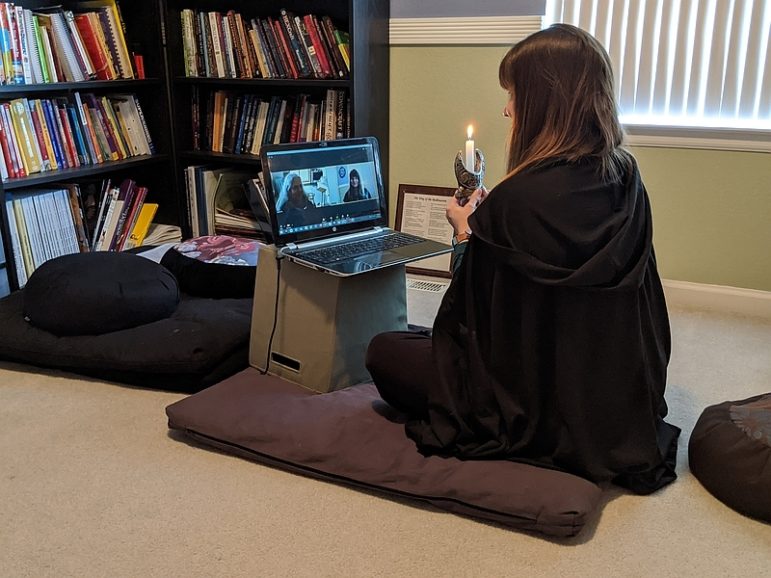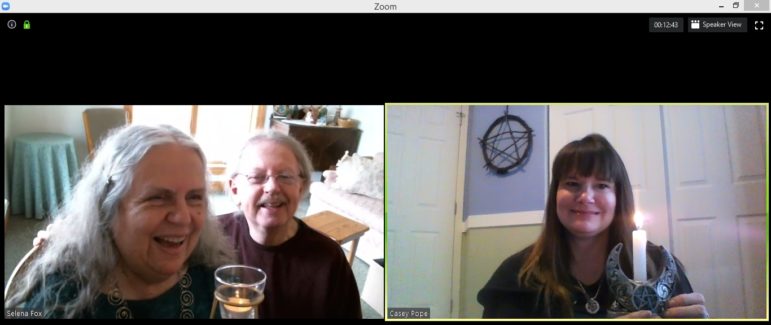BARNEVELD, Wis. – Only once has Brianne Ravenwolf experienced online a Cone of Power, like those of F2F rituals. But said it can be done!
Ravenwolf, a digital migrant, volunteers at Circle Sanctuary. A digital migrant refers to someone who encountered the Internet as an adult whereas a digital-native has no memory of a world without the Internet. She credited the Cone of Power success to lots of planning. It required lots of coordination, camera work, chat monitoring, and lighting, but that it is very possible.
The online ritual experience and all its elements have become more familiar to many Pagans. The COVID-19 pandemic has temporarily made many face-to-face (F2F) group rituals a thing of the past. But many Pagan groups have responded to the challenge and replaced F2F group rituals with online rituals.
Recently, The Wild Hunt spoke with Selena Fox, Brianne Ravenwolf, and Casey Pope about their experiences with the online rituals currently being held by Circle Sanctuary.

Selena and Casey – circles of connection – Image courtesy of C. Pope
The basics of video conferencing technology
In an attempt to connect people since F2F meetings are currently not possible, a variety of platforms have become popular for online rituals. Depending on the platforms used, Pagans can broadcast online rituals live or prerecord them. Some use software that has traditionally been used for online meetings like Zoom or Webex while some others use apps like “House Party” or video chat using Facebook Messenger.
To begin with, some terminology helps explain the experience. The term “on-site” refers to the physical location where the ritual lead is performing the ritual. The term “off-site” refers to additional physical locations throughout the world where participants are taking part in the ritual and not in the same physical space as the ritual leaders.
Those ritual leaders not only have the responsibility for the ritual but they also manage the technical aspects of the ritual, and perform the key dramatic roles in the ritual or assign specific individuals to carry out these duties.
The “site” may be metaphorical in cyberspace, and also involves off-site participants who are practicing from their own homes. They may have no technical or dramatic role in the online ritual but participate nevertheless.
Most video conferencing software allows for both text chat as well as live streaming of audio and video. This allows verbal participation without disruption to the main presentation. While one window shows the main presentation, people can enter questions in a chatbox. Someone monitors that chatbox. Off-site participants with microphones can also speak to the group. Some video conference technology allows off-site participants with video cameras to send videos of themselves to the metaphorical “site.”
Circle Sanctuary online
Delivering content via digital means is not new to Circle Sanctuary. Selena Fox said Circle Sanctuary has been broadcasting podcasts since 2019. People can download podcasts from the Internet, or stream them through a variety of podcast apps. Last year, Circle Sanctuary expanded from two podcasts to a network of six podcasts. Two podcasts are bilingual (English-Spanish, and Spanish-Portuguese). These podcasts include discussions, interviews, rituals, and workshops.
In January 2019, Selena Fox began creating video workshops and rituals. On April 12, Circle live-streamed an Interfaith, Pagan-Centered “Easter Blessings of Healing & Wellness” for those affected by the pandemic on her main Facebook page.
In March of 2019, Fox began using the Instagram app IGTV to broadcast. It is important to note that IGTV is currently only available on mobile devices, and not laptops or computers.
Recently she has posted short healing rites/meditations for those impacted by COVID-19 on Selena Fox IGTV.
This year, Circle Sanctuary began to use video conferencing software on social media. Circle Sanctuary has broadcast its “Welcome Spring Festival” (March 21), a Full Moon ritual (April 6), and its Earth Day ritual (April 18).

Selena and Casey – candles of connection – Image courtesy of C. Pope
Personal experiences
Ravenwolf neither plans nor performs in ritual. But Casey Pope, a digital native, has helped plan online rituals in both technical and “performance” roles. Both are speaking for themselves rather than Circle Sanctuary.
Ravenwolf thinks that “[the] more we do online work, the similarities [to F2F rituals] will be there.” She prefers Zoom and reports having had better ritual and spiritual experiences with that software though still prefers F2F rituals.
Pope stressed that “The rituals I have attended have not been videos of F2F ceremonies, but instead have been interactive in the sense that one or more ritualists are facing the camera, presenting in an interactive fashion with those attending the ritual.” She credits Zoom software for allowing off-site participants “to see the screens of the participants if they have their video on. One can see expressions on other’s faces and see whether or not they are participating in the activities.”
Ravenwolf considers that a major challenge in producing online rituals lies in making it feel like a F2F ritual. She feels that clergy should now be experienced in working online rituals. She also placed great importance on creating a “setting that looked and felt like being in a F2F circle.” That requires a good technical crew that has camera and lighting skills.
Pope has found it challenging to design a “cyber ritual that is engaging and participatory … Special efforts must be made to include participants. Participants can engage in simultaneous activities, such as lighting a candle, chanting, or holding up a ritual item.” She continued, “Chanting along with the presenting ritualist can be very powerful, especially knowing many others are doing exactly the same thing at the same time!”
Some of this challenge is technical. If an off-site participant speaks through a microphone, a time lag can occur before others will hear them. To avoid background noise, though, ritual leaders often request that participants mute their microphones.
For Circle Sanctuary rituals, only on-site participants have live microphones. Ravenwolf continued, “Chanting is a powerful way to raise energy.” She felt this works even when the microphones of off-site participants have been muted.
Ravenwolf found the introductions to online rituals to be particularly moving. As those who are gathered in virtual ritual space say their name and where they are, it becomes clear that people from all over the world are present. She said that those introductions make her feel like, “we’re all there together.”

Selena, Dennis, and Casey conducting a remote ritual – Image courtesy of C. Pope
Grieving the absence of F2F rituals
Pope urged potential off-site participants to “be open to a new style of ritual … Prepare yourself as you would for face-to-face ritual – take a ritual bath, put on special clothing, meditate beforehand to get in the right mindset.”
She urged people with web cameras to “turn your video on so others can see and connect with you visually.” She also recommended participants to connect to the video conferencing app five to ten minutes early. This will avoid the disruption of people logging on after the ritual has begun, as well as allow time to work out any technical issues before the ritual begins.
“Now is a great time to take advantage of opportunities to attend rituals from places that you otherwise might not be able to attend.” Pope continued, “Connect with a faraway group or explore a new tradition.”
Circle Sanctuary welcomes participants at their live-streamed rituals.
Their next event will be an online Beltane festival and ritual on May 2. Circle Sanctuary has posted info about their Beltane Festival and Ritual event on their website. Those interested can find rituals and events of Circle Sanctuary on their website and Facebook pages.
The Wild Hunt is not responsible for links to external content.
To join a conversation on this post:
Visit our The Wild Hunt subreddit! Point your favorite browser to https://www.reddit.com/r/The_Wild_Hunt_News/, then click “JOIN”. Make sure to click the bell, too, to be notified of new articles posted to our subreddit.
